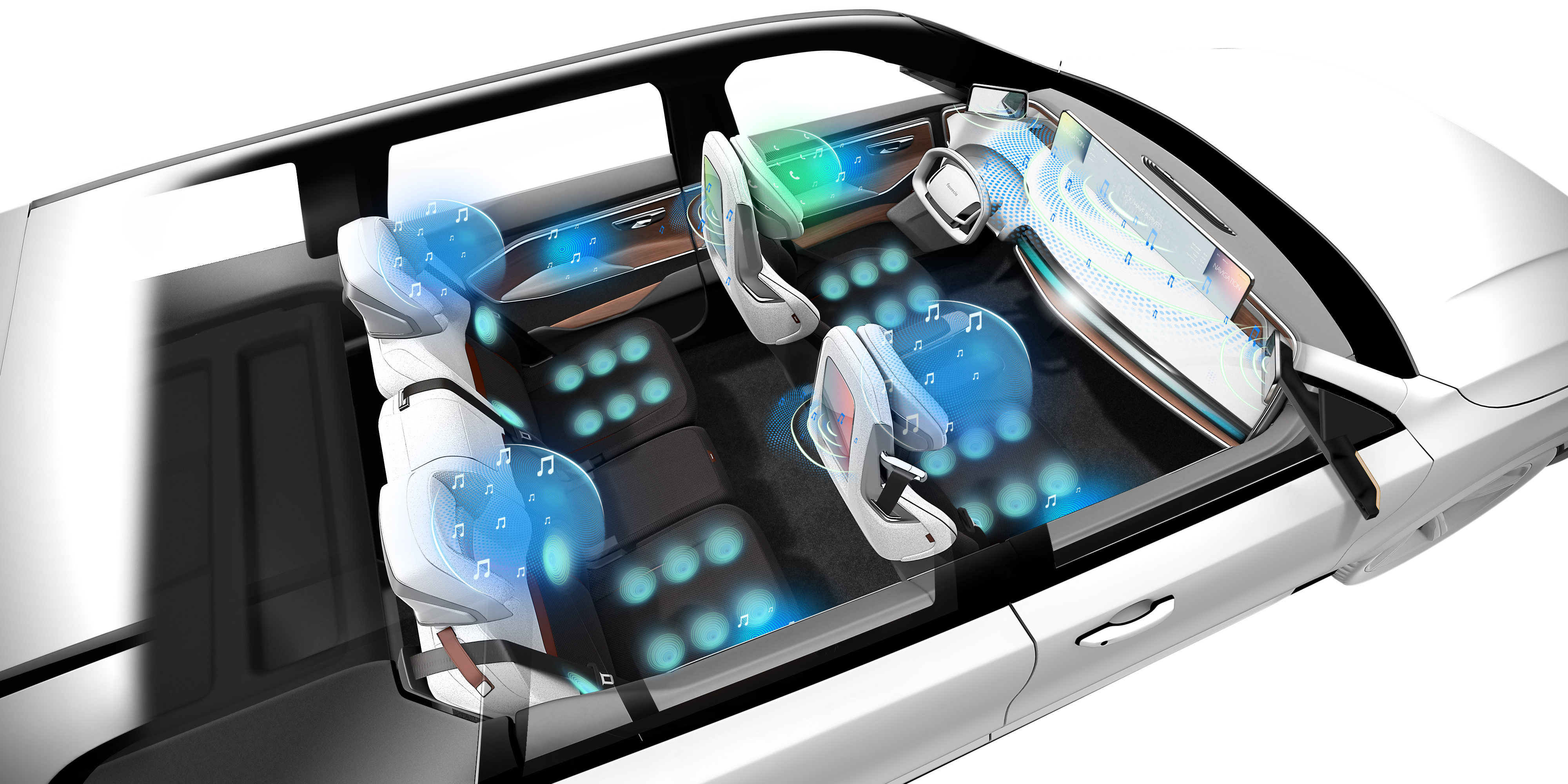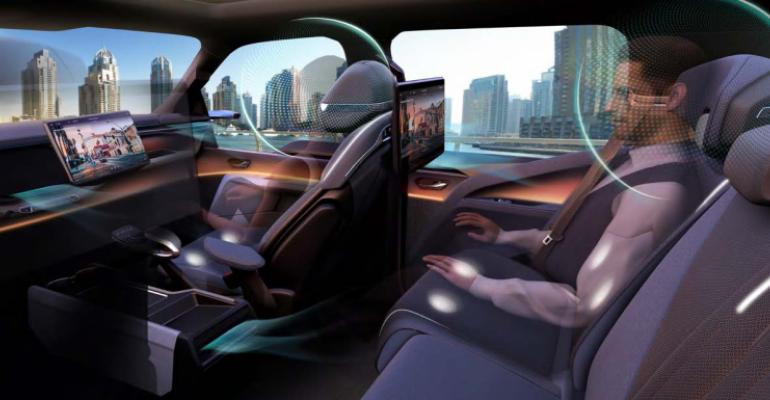“Vehicle cabin monitoring” doesn’t sound exciting, but it’s on the verge of changing the world. It will define the cockpit of the future, transform mobility and make drivers and passengers safer, happier and healthier.
It’s creating a new supplier ecosystem and many new partnerships between big companies and small startups. Companies are collaborating to create hardware, software and networks of sensors inside and outside the vehicle that interpret data and turn information into actions and services.
 Those actions range from preventing driver distraction to numerous wellness and safety functions in shared vehicles. Cabin monitoring also will create personalized ways of cheering up stressed-out drivers. “The goal is understanding the consumer and creating the right technology,” says Karim Chaiblaine, vice president-Cockpit of the Future, Faurecia North America (pictured), during a presentation at the recent TU-Detroit Festival of Automotive conference. Faurecia is a $21 billion (€18 billion) company with 248 plants and 37 R&D centers around the world. Sustainable mobility and developing cockpits of the future are its two main initiatives.
Those actions range from preventing driver distraction to numerous wellness and safety functions in shared vehicles. Cabin monitoring also will create personalized ways of cheering up stressed-out drivers. “The goal is understanding the consumer and creating the right technology,” says Karim Chaiblaine, vice president-Cockpit of the Future, Faurecia North America (pictured), during a presentation at the recent TU-Detroit Festival of Automotive conference. Faurecia is a $21 billion (€18 billion) company with 248 plants and 37 R&D centers around the world. Sustainable mobility and developing cockpits of the future are its two main initiatives.
What does cabin monitoring do?
The objective of cabin monitoring is creating contextual awareness outside and inside the cabin, understanding consumers’ daily lives and finding solutions for things that bother them, Chaiblaine says.

Driver monitoring systems and occupant monitoring systems.
An electronic network connects the inputs of various sensors, enables the user experience interfaces and provides a menu of services for passengers and drivers in personal and shared vehicles, Chaiblaine says.
What’s Driving Cabin Monitoring?
Currently, interior monitoring is driven by government regulations in Europe, the U.S. and China, focusing on driver drowsiness and distraction issues.
However, once these sensors are installed in vehicle cabins, they also can be used to create immersive user experiences for wellness and comfort features.

On-demand wellness and comfort features are new frontier for future cockpits.
Faurecia is positioned to provide these solutions from a software and hardware perspective through its divisions and business groups in Seating, Interiors and Clarion electronics, Chaiblaine says.
Using these tools, Faurecia can create dynamic active noise cancellation bubbles in the vehicle cockpit that can provide personalized comfort and wellness zones for occupants. The cabin camera installed to detect driver distraction issues can also be used to track occupant ear position in order to direct the sound-cancelling waves in the right direction.
What are the benefits for Shared Vehicles?
Dynamic personal comfort can be improved by using the camera to track body dimensions, so the comfort and wellness of the user is enhanced inside the car.
Driver-distraction and drowsiness-monitoring tools also can serve the greater purpose of improving safety in shared vehicles.
Chaiblaine says thousands of support requests are received daily by mobility providers, but they don’t know immediately the severity of such requests.
The contextual awareness of interior monitoring systems can give mobility providers the ability to understand and prioritize safety concerns within vehicles, Chaiblaine says.
Validating solutions and results
In order to develop and validate such types of solutions Faurecia has developed a partnership with Wingz, led by CEO Christof Baumbach, a mobility service provider based in San Francisco that focuses on airport rides and non-emergency medical transfers.
Wingz operates in 15 cities in the U.S. including San Francisco, Los Angeles and San Diego. The partnership enables Faurecia to quickly test and validate various features and strategies.
Chaiblaine says Wingz is a great platform for tests because typically the duration of a trip is 30 minutes, enough time for people to experience the product.
The importance of partnerships
“Through this partnership, Faurecia gets the perspective of the mobility provider in order to create the right product and understand the consumer need,” Chaiblaine says. “I strongly believe automotive and mobility as a whole are best improved with the mindset of partnership.”
Faurecia and Wingz are working on two key projects. The first is about driver and cabin monitoring in order to increase the perception of safety as a whole. The second project is aimed at creating a response to COVID that will increase safety for passengers and drivers and bring back trust in ride hailing.
“It’s obvious all facets of mobility have suffered during the current crisis,” Chaiblaine says. “In order for our broader business and industry to be successful post-COVID, we need to build strong networks, not only for commercial engagements but also in order to solve the most pressing problems in the world.”
The biggest challenges
The biggest challenge to implementing cabin monitoring in ride sharing vehicles is regulatory, not technical, Chaiblaine says.
“Just think about getting approval to film somebody in a vehicle. Each country has its own regulations,” he points out. Faurecia is working with Wingz now on waivers and information for passengers, but working in a public environment, essentially as an extension of public transportation, means a multitude of safety and security issues have to be addressed.
“Every problem, every concern you have in a metro, bus on a train station platform, that’s what you see in a ride-handling environment,” Chablaine says.
The other hurdle is operational implementation. Cabin-monitoring systems will be deployed widely in coming years. Developing an industry standard for cabin monitoring and safety will be a challenge.
How is COVID impacting development?
Public transit and mobility providers have lost 80% of their traditional businesses, says Chaiblaine, pointing out that mobility service providers are pivoting to more sustainable services in the interim such as delivering food, not transporting people.
Reducing potential exposure to the coronavirus and bringing back trust in vehicle sharing is the most vexing issue of the day.
Automakers and suppliers are looking at ways of decontaminating vehicle interiors with the use of specific spectrums of ultraviolet light, virus-killing interior materials, high-tech air filtration and decontaminating sprays. But they are only part of the solution. Direct exposure to UV rays or disinfectants can be harmful. Users of shared vehicles or autonomous vehicles will need to know how and when the vehicles are safe to occupy.
Sanitization technology providers are creating smart systems to ensure the consumer always is protected, and there is no harm from the use of UVC or other technologies.
Chaiblaine says a human-machine interface can be used to monitor activities, activate sanitizing systems and signal when they are finished.
“I can’t disclose everything, but we’re working on two key solutions. Broad UV (ultraviolet light) solutions can be used to target surfaces like instrument panels, first- and second-row seats and door panels.
“But we’re also working on localized sanitizing solutions targeting door handles, window switches and steering wheels. These solutions are able to run for a specific duration to kill the virus and then deactivate.”
The HMI then will communicate with the driver and passengers with lights or displays to signal the system has run for a time sufficient to kill the virus, Chaiblaine says.
“We work with a scientific group to keep learning how the pathogen transmits. Because it transmits not just through touch but through air, we are working on a solution that would clean the environment through air filtration and UVC light (a spectrum between visible and X-rays that is useful for sanitizing). We are ready for co-development,” Chaiblaine says.
“We’ve had multiple meetings with OEMs recently to deploy and develop our solutions,” he adds. “Hopefully a COVID-19 vaccine will be available soon, but we have to remember that someday there may be a COVID-22 or -23 because that is the nature of the pathogen. The risk of pandemic has always been there.”
Can cabin monitoring improve an occupant’s mood?
Chaiblaine admits it’s difficult to quantify how a passenger’s mood has improved. But at CES last January Faurecia demonstrated numerous technologies that show using artificial intelligence, facial recognition and other biometrics can detect if someone is tired, angry or sad and it can react by playing their favorite music or nature sounds, activating soothing lighting effects and offering seat massages, in-car exercise programs and uplifting podcasts.
Some of these features are designed to be purchased on demand through smartphone apps in a vehicle sharing scenario.

Biometrics can detect if someone is tired, angry or sad and can react by playing favorite music or nature sounds, activating soothing lighting effects and offering seat massages.
“These demonstrations show a high impact on people’s emotion through switching the character of the cabin into something livelier and more human, and it triggers a positive attitude from people who experience it. So the answer to the question is yes.”
Wards was able to experience these features at the CES demo and we can confidently predict that in the cockpit of the future, you won’t be able to buy happiness, but you will be able to pay for a better mood.





